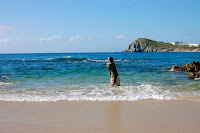Whether your targeting saltwater or freshwater species, it's always helpful to have some knowledge of what your catching. Studying your target species is a simple, but effective solution to becoming better angler. In order to be a complete angler, it is important to not only know how to catch fish, but to know what they're about. In my opinion, fish knowledge goes much further than knowing what baits work the best. Other areas to consider when studying your target species are: diet, habitat, migration, spawning season, and of course regulations regarding that particular species.
There are many resources that are available for this type of information, but the two websites that have been most helpful to me are the California Department of Fish and Wildlife site and FishBase.
The
California Department of Fish and Wildlife (formerly Department of Fish and Game) website has a lot of information for California native species, both fresh and saltwater. The site also gives you all the information you need regarding rules and regulations for specific species. You can either browse through the site or search directly on the top right corner.
Fish Base has some good, to the point, information for a wide variety of species. However, from my experiences Fish Base loads very slow so you'll have to be patient.
New 2013 Saltwater Bass Regulations
Effective March 1, 2013, the California Department of Fish and Wildlife has changed saltwater bass regulations for conservation reasons. The following species are under these new regulations: Spotted Bay Bass, Calico Bass, and Barred Sand Bass. The new regulations are the following:
- 14 inch minimum length with a legal filet length of 7 1/2 inches on all saltwater bass species (previously 12 inch minimum length)
- 5 fish limit in any combination (previously 10 fish limit)
These new regulations are good for conservation so future generations will be able to enjoy these amazing species. However, they will have an effect on sport-fishing charters and tournament series. For example, these regulations are going to make it harder for sport-fishing charters to reach their bag limit. For tournament anglers the regulations make it harder to pull in legal sized bass to weigh in. From my standpoint, I'm okay with these new regulations because it will be conserving our fishery and making saltwater bass fishing that much more challenging.






















